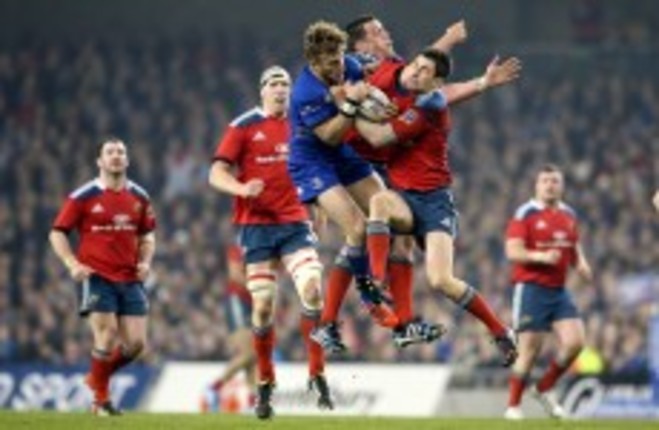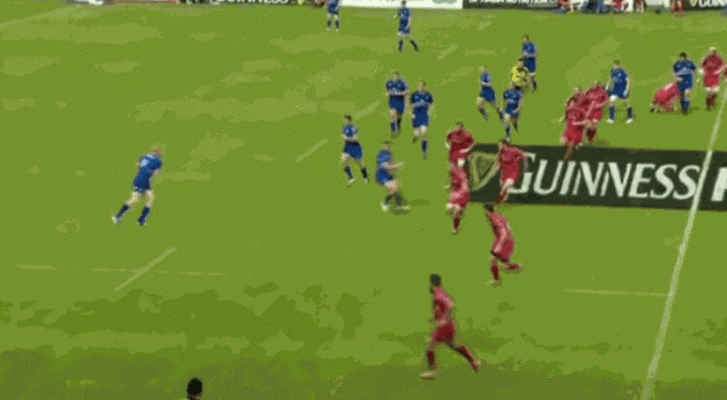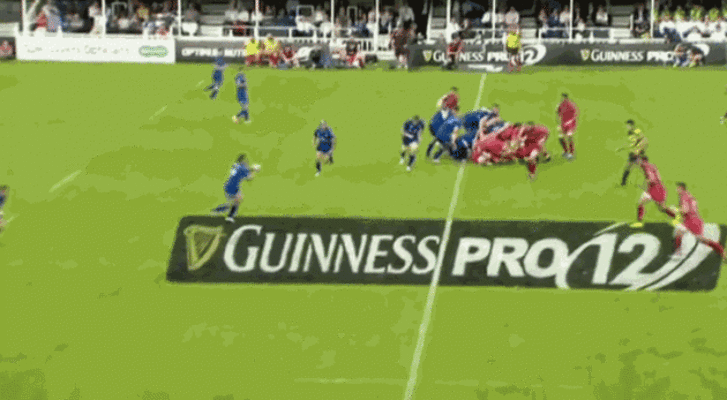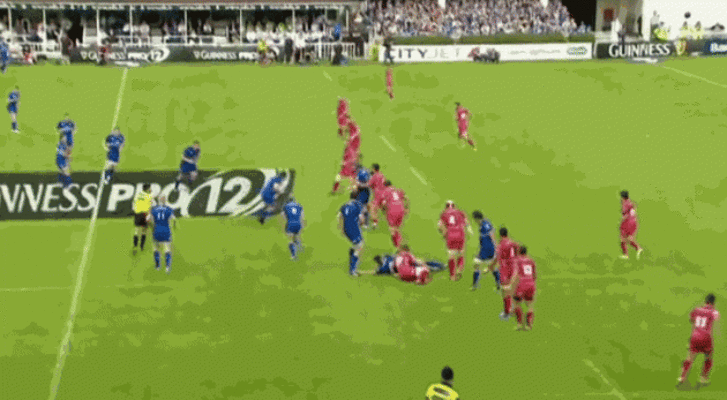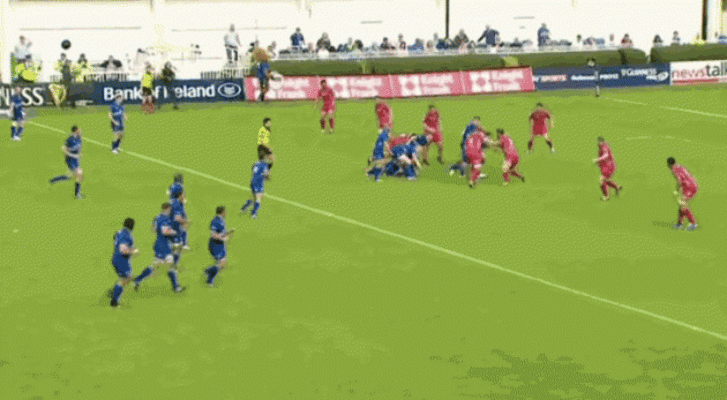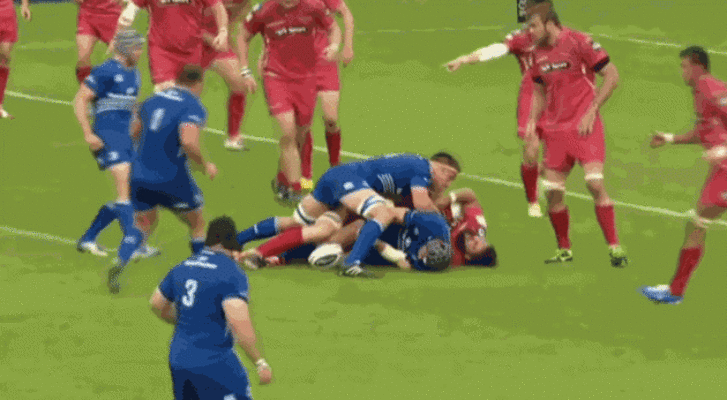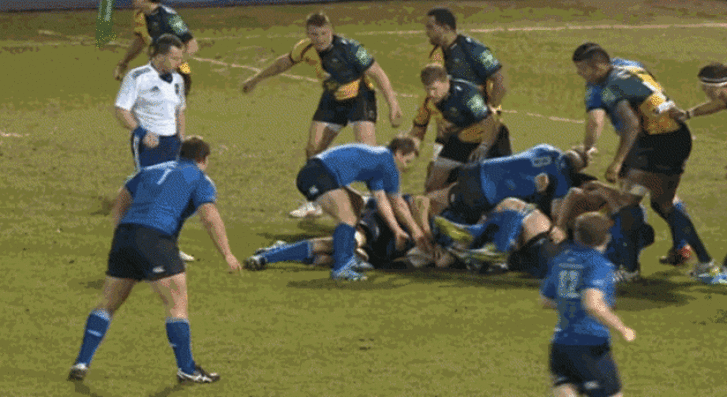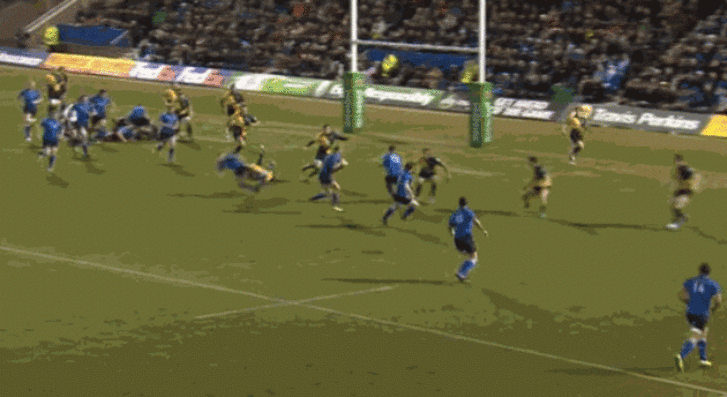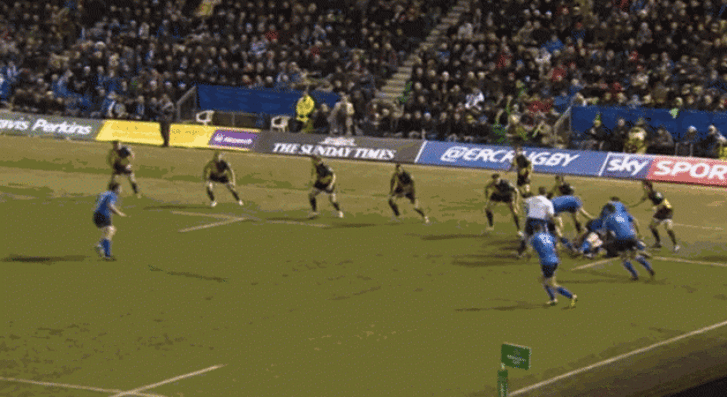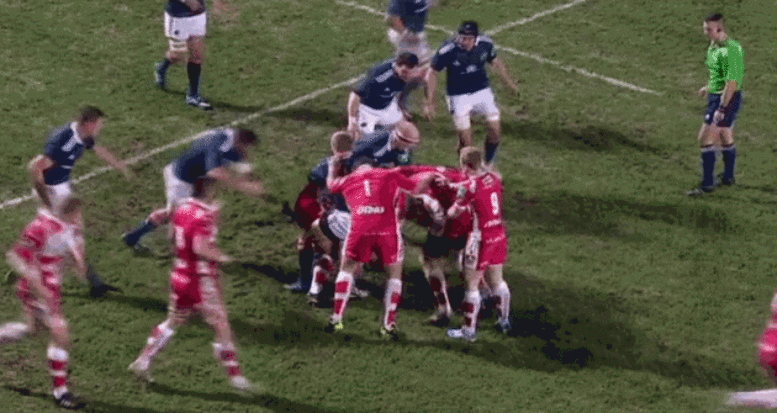IT’S EASY TO say that the breakdown is going to be the key feature of any game, but tomorrow’s clash between Leinster and Munster is likely to witness a particularly important battle around the tackle area.
With both sides yet to hit convincing form in the early stages of the season, neither have fully demonstrated the strengths that have made them forces in seasons past.
When Leinster get rapid ruck ball, they are close to unstoppable, while Munster’s defensive breakdown ability has helped them into two Heineken Cup semi-finals in the last two seasons.
“It’s the biggest key,” says Leinster fullback Rob Kearney of the breakdown in tomorrow’s Guinness Pro12 encounter at the Aviva Stadium.
I think to be fair to Munster, their biggest strength is slowing down ball at the breakdown. So that’s where the game is going to be won and lost this week. If we get quick ball, if we’re accurate at the breakdown, then I like to think that as a backline we can do a bit of damage and create stuff.
“The big challenge for the forwards is to clean those rucks quickly, get there early and be accurate, because Munster are a superb team at spoiling ball at breakdowns.”
Two-second rucks
Leinster’s strongest performance of this campaign so far came in round two, when they scored six tries in beating the Scarlets 42-12 at the RDS. While the Welsh region delivered an extremely weak performance, it was no surprise that Leinster’s ruck speed in that game was swift.
We get a couple of good examples in the clip above, as Leinster attack over six phases to score through Kearney. It takes Leinster just 55 seconds to manufacture the try and there are several key breakdown contributions.
On phase two [below], we see Brendan Macken and Kearney clearing Scarlets openside John Barclay away as he goes in for the poach. Kearney mentions above that there is a particular onus on Leinster’s forwards at ruck time, but the backs will be required to chip in regularly against Munster, as in the example below.
The results of Macken and Kearney’s accuracy in the GIF above is that Leinster have a ruck that lasts around 2.8 seconds and can attack the Scarlets defence before they have ample time in which to get settled.
That lack of organisational time means the Scarlets D is narrow and Leinster manage to skirt it on the left edge, making big gains and forcing the Welsh side further on to the back foot.
Later in the same half, Leinster go through ten phases in 1 minute 15 seconds to create a try for Ian Madigan [above], and again the contributions around the breakdown are essential in allowing the province to flourish in attack.
On the very first phase [below], Jamie Heaslip comes up trumps as Barclay rebounds up onto his feet to compete for the pill after tackling Madigan. It goes without saying that any team is going to enjoy a better day at the breakdown if their carriers can get over the advantage line, but there still needs to be accuracy in the clearing out.
Heaslip’s accuracy here, wrapping his right arm around Barclay’s neck and driving him off the ball, helps Leinster to a 2.5-second ruck.
Two phases later, we see a contribution from Jack McGrath that doesn’t really affect the speed of the ball coming out of the ruck, but does indicate a ruthlessness on Leinster’s part in this area.
We see in the GIF below that Barclay is on the ground just to the left of the Leinster ruck after making a low tackle on Mike Ross. While the Scarlets flanker is not directly slowing the ball, he is in a position where he could get in the way of Isaac Boss’ release.
McGrath spots Barclay and arrives in to drop a shoulder into his back, a sharp reminder that he is unwelcome in that area around the breakdown. The Leinster loosehead’s action reflects a clinical mindset from Leinster in their ruck, something they will need to bring tomorrow evening against Munster.
On phase five [below], Mick McGrath picks and carries strongly, but gets a little isolated in doing so. The Scarlets scrum-half Rhodri Williams gets into a great jackal position to make the steal, but Madigan is the man to deliver for Leinster this time.
Heaslip misses the first-up clear-out on Williams, sliding off to his right, but Madigan gets his centre of gravity low enough to drive Williams away on Leinster’s second attempt.
Again, the Irish province’s forward momentum is key, but Madigan still has to shift his weight smartly and drive Williams away.
Leinster very nearly blow the try opportunity on phase nine, but Heaslip makes a crucial, and probably illegal, intervention. McGrath picks and trundles forward, becoming isolated and allowing prop Rhodri Jones a glimpse of the turnover.
Heaslip spots the chance at almost exactly the same time, hurdles the previous ruck and blasts in from the side to clear Jones. The fact that Dominic Ryan arrives in concurrently is probably the reason Heaslip is not pinged, as the referee focuses on the flanker’s actions, rather than the No. 8′s.
This is not to say that Leinster should be flying in the side of rucks against Munster, but that desperation to clear our defensive bodies is what they will look for. Nine phases into an attacking passage and short of breath, it would have been easy for Heaslip to let Jones clamp onto the ball.
Peaking under O’Connor
Leinster’s best performance during Matt O’Connor’s reign so far was undoubtedly the 40-7 win over Northampton Saints in the Heineken Cup pool stages last season. It is no coincidence that the province had a frightening ruck speed that evening.
While Leinster haven’t really hit this peak since, it does demonstrate exactly what they can do when they blast rucks in attack. We’ll just take a look at one example to hammer home the point.
It’s a remarkable six-phase attack from Leinster, as they score a try just 40 seconds after the initial line-out on the left. In the midst of the quality handling, ambition and invention, there are some excellent involvements around the breakdown.
On phase two, it’s Mike McCarthy who steps up to clear Saints prop Alex Waller from a threatening position. As a result, Eoin Reddan can clear the ball away less than two seconds after McGrath hits the deck.
Next up is Gordon D’Arcy, who removes Dom Waldouck from a decent position after Luke Fitzgerald carries into contact. Again, Leinster can move away after a ruck that lasts under two seconds.
On the fifth phase, McCarthy and McGrath combine to deliver yet another sub two-second ruck, with the Saints literally looking stunned by the speed of the Leinster attack.
The fact that we have to go back to December 2013 to locate these examples of Leinster’s breakdown peak – there were many, many more illustrations of it in this game – perhaps suggests why the province’s attacking game has not looked as fluid in recent times.
As O’Connor looks for Leinster to strengthen their use of possession in the opposition half, the breakdown will be a key area of concentration.
100%. It’s always a focus, there’s 100+ breakdowns in a game,” says O’Connor. “From that end, you’ve got to make sure that you get dominance there and you get quick release. It’s something that we drive every weekend.
“It’s a little bit realer this week because Munster will present a significant challenge in that area, they will devote a lot of their energies to slowing our release. We’ve got to back ourselves to be more accurate than them there.”
Munster finding their feet
Kearney and O’Connor both point to Munster’s strength defensively at the breakdown, but it’s an aspect of the game where the southern province have yet to click into top gear.
While they have, at times, managed to slow opposition possession, Anthony Foley’s side have not yet started to win clean steals and turnover penalties as frequently as they did last season under Rob Penney.
The fact that Peter O’Mahony and Damien Varley have been missing has been partly responsible for that, given that duo’s ability around the breakdown.
That both players are back in the match day squad for tomorrow is a major boost, and Foley will look for strides of growth in this area in the coming weeks.
Among the starting XV tomorrow, the likes of Paul O’Connell, James Cronin, Tommy O’Donnell, Robin Copeland and CJ Stander will be asked to pose a muscular threat to the speed of Leinster’s breakdown possession.
Not that competing for possession at the breakdown against Leinster is any different to how Munster usually operate.
[Leinster] do thrive on quick ball and we need to put certain players under pressure and slow up their ball, but that’s something you focus on with any team really,” says Copeland.
“It’s something that we’ve talked about, but it’s not that much different to what we usually talk about.”
A fascinating encounter awaits as both Irish provinces look to make breakdown progress.
